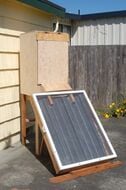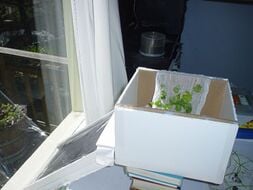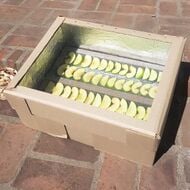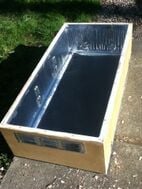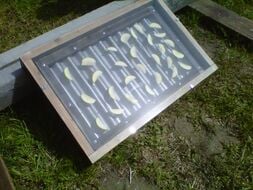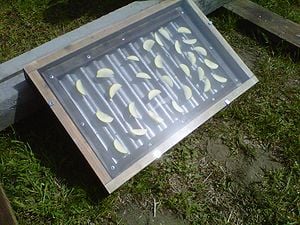
A solar dehydrator (or solar drier) allows the user to preserve food without the energy cost or pollution associated with other drying techniques.
Agricultural and other products have been dried by the sun and wind in the open air for thousands of years. The purpose is either to preserve them for later use, as is the case with food; or as an integral part of the production process, as with timber, tobacco and laundering. In industrialised regions and sectors, open air-drying has now been largely replaced by mechanised dryers, with boilers to heat incoming air, and fans to force it through at a high rate. Mechanised drying is faster than open-air drying, uses much less land and usually gives a better quality product. But the equipment is expensive and requires substantial quantities of fuel or electricity to operate.
'Solar drying' in the context of this technical brief, refers to methods of using the sun's energy for drying, but excludes open air 'sun drying'. The justification for solar dryers is that they may be more effective than sun drying, but have lower operating costs than mechanised dryers. A number of designs are proven technically and while none are yet in widespread use, there is still optimism about their potential.
Types[edit | edit source]
Rice solar dryer[edit | edit source]
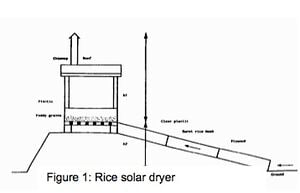
One well-known type of solar dehydrator is shown in Figure 1. It was designed for the particular requirements of rice but the principles hold for other products and design types, since the basic need to remove water is the same.
Air is drawn through the dryer by natural convection. It is heated as it passes through the collector and then partially cooled as it picks up moisture from the rice. The rice is heated both by the air and directly by the sun.
Warm air can hold more moisture than cold air so the amount required depends on the temperature to which it is heated in the collector as well as the amount held (absolute humidity) when it entered the collector.
The way in which the moisture absorption capability of air is affected by its initial humidity and by the temperature to which it is subsequently heated is shown in Table 1.
The objective of most drying processes is to reduce the moisture content of the product to a specified value. Moisture content (wet basis) is expressed as the weight of water as a proportion of total weight. The moisture content of rice has typically to be reduced from 24% to 14%. So to dry one tonne of rice, 100kg of water must be removed. If the heated air has a 'absorption capacity' of 8g/m3 then 100/0.0008 = 12,500/m3 of air are required to dry one tonne of rice. The heat required to evaporate water is 2.26kJ/kg. Hence, approximately 250MJ (70kWh) of energy are required to vaporise the 100kg water. There is no fixed requirement for solar heat input to the dryer. This is because the incoming ambient air can give up some of its internal energy to vaporise the water (becoming colder in the process). Indeed, if the ambient air is dry enough, no heat input is essential. Nevertheless, extra heat is useful for two reasons. First, if the air is warmer then less of it is needed. Second, the temperature in the rice grains themselves may be an important factor, especially in the later stages of drying, when moisture has to be 'drawn' from the centres of the grains to their surfaces. This temperature will itself depend mainly on the air temperature but also on the amount of solar radiation received directly by the rice. In a natural convection system, the flow of air is caused by the fact that the warm air inside the dryer is lighter than the cooler air outside. This difference in density creates a small pressure difference across the bed of grain, which forces the air through it. This effect increases, the greater is the height of the bed above the inlet (h1) and the outlet above the bed (h2). The effect of an increased h2 is less than that of an increased h1 because the air is cooled as it passes through the bed. Approximate densities for a variety of cases are shown in Table 2Forced convection solar dryer[edit | edit source]

By using a fan to create the airflow, drying time can be reduced by a factor of 3. Also, the area of collector required is reduced by up to 50%. Therefore, the area of collector required for a given throughput of product could be reduced by a factor of 5-6. The initial cost of a one tonne per day dryer is in the region of £1500-2000. The fan would consume about 500 watts for 6 hours, and so electricity cost (at 0.07/kWhr) would be about 0.20 per tonne of rice dried
Tent dryer[edit | edit source]
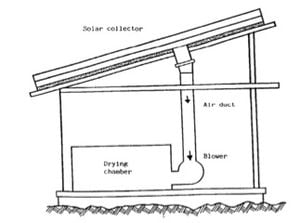
The distinguishing feature of tent, box and cabinet dryers is that the drying chamber and the collector are combined into one, see Figure 3. This allows a lower initial cost. Drying times are however not always much lower than for open-air drying. (Probably, insufficient attention has so far been paid to utilising natural convection.) The main purpose of the dryers may be to provide protection from dust, dirt, rain, wind or predators and they are usually used for fruit, fish, coffee or other products for which wastage is otherwise high. There are numerous other types. Greenhouse dryers are a more sophisticated version of tent dryers. Box dryers may incorporate thermal insulation to achieve higher temperatures. Storage bin dryers combine the functions of drying and long-term storage. Solar timber kilns may include hot water storage to enable the necessary control of drying rate.Solar drying or open-air drying?
Firstly, one important advantage of solar drying is that the product is protected from rain, insects, animals and dust that may contain faecal material. Some systems also give protection from direct sunlight. Second, faster drying reduces the likelihood of mould growth. Third, higher drying temperatures mean that more complete drying is possible, and this may allow much longer storage times (but only if rehumidification is prevented in storage). Finally, more complex types of solar dryers allow some control over drying rates.
Which solar dryer?[edit | edit source]
The choice between alternative types of solar dryer will depend on local requirements and in particular on the scale of operation. If intended for peasant farmers then initial capital cost may be the main constraint and plastic-covered tent or box dryers may be appropriate.
There may however be a trend towards more centralised drying to enable more intensive usage of the equipment. The greater initial cost of glass covers may then be affordable, and grid electricity may be available to run fans and obtain much faster throughput for a given collector area.
For intermediate scale and capital cost the natural convection rice dryer is a well proven design.
The choice between using solar radiation or fuel, to heat the air is mainly one between a higher initial cost and continuing fuel costs which needs to be analysed for each location. In some circumstances, it may be possible to burn rice husks or other fuel with low opportunity cost. One ton of rice gives 200kg of husks. Fuel heating usually allows better control of the drying-rate than solar heating; it also enables drying to be continuous. If either of these is required, a combined system may be appropriate with pre-heating of air by solar energy.
Related projects[edit | edit source]
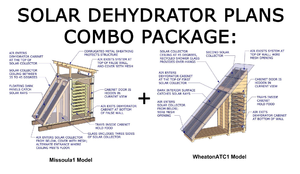
Here are all the Appropedia original projects that show how to make or build a solar dehydrator. Feel free to add your own by creating a page and adding "Solar dehydrator" to the "Instance of" parameter in the project data box.
See also[edit | edit source]
- Drying of foods (Practical Action Brief)
- Food drying with superheated steam
- Small Scale Drying technology (Practical Action Brief)
External links[edit | edit source]
- Solar dehydrator designs at Permies.com
- Solar dehydrator plans at Permies.com
- Solar dehydrator movie at Permies.com
Further reading[edit | edit source]
- Drying of Foods (Practical Action Technical Brief)
- Drying Technologies Practical Action Technical Brief
- Tray Dryers Practical Action Technical Brief
- The Anagi Tray Dryer Practical Action Technical Brief
- Construction and Use of a Simple Solar Drier to Preserve Food for Off Season HEDON
- Household Energy Network
- Drying Food for Profit: A Guide for Small Business Barrie Axtell, ITDG Publishing, 2002
- Setting up a Food Drying Business: A Step-by-Step Guide Fabrice Thuiller, ITDG Publishing, 2002
- Solar driers Commonwealth Science Council, 1985
- Solar drying: Practical methods of food preservation, ILO, 1988
- Producing Solar Dried Fruit and Vegetables for Small-scale Enterprise Development, NRI 1996
- Try Drying It! Case studies in the dissemination of tray drying technology, Barrie Axtell & Alex Bush, IT Publishing, 1991
| Keywords | solar, solar cooker, energy |
|---|---|
| SDG | SDG07 Affordable and clean energy |
| License | CC-BY-SA-3.0 |
| Language | English (en) |
| Translations | German, Portuguese, Korean, Chinese, Dutch, Japanese, Spanish |
| Related | 7 subpages, 251 pages link here |
| Aliases | Solar Drying, Solar dehydrating, DIY solar food dehydrator projects, DIY solar dehydrator projects, Original:Solar drying, Solar dehydrators |
| Impact | 1,411 page views (more) |
| Created | February 25, 2008 by Lonny Grafman |
| Last modified | October 16, 2024 by Felipe Schenone |
| Cite as | "Solar dehydrator". Appropedia. 2008–2024. Retrieved October 29, 2024. |
| API queries | basic, semantic, html, files, more |
